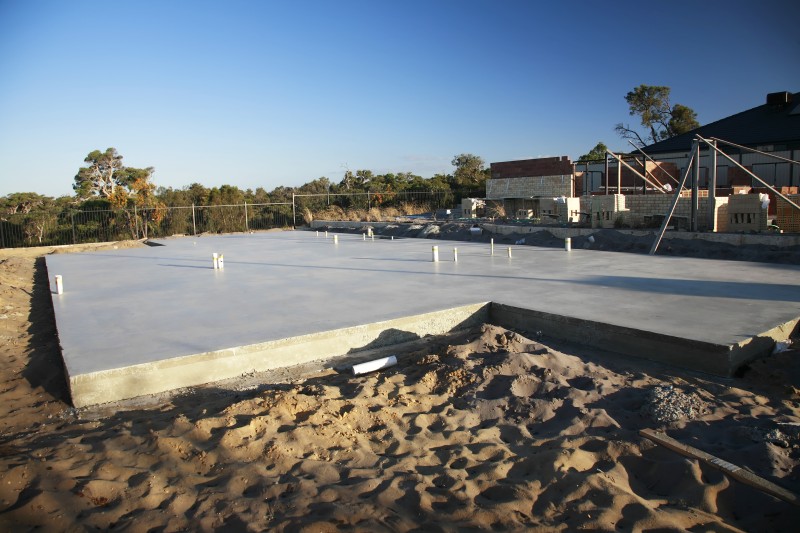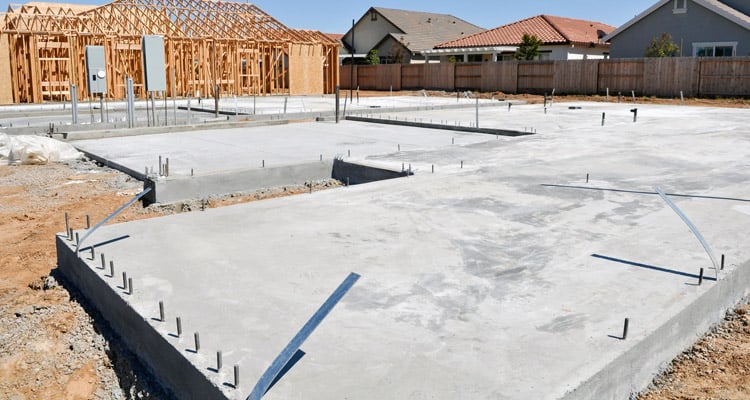In this article we will explain and discuss the Pros and Cons of Concrete Slab Foundation for Homes, so let’s get started.

Seeking to explain the importance of the role concrete plays in the world, Daniel Faris was commissioned to craft a ZME Science article asking this intriguing question: “Concrete practically surrounds us, but how many of us really know what it is?”
Readers quickly learn that “Almost every building project on the planet uses concrete at some point. From bridges to swimming pools to highways, concrete has probably been used to construct it. It’s versatile, relatively inexpensive, and it endures under punishing conditions,” Faris concludes.
Now that you understand the scope of this critically important building material, it’s time to learn that the word cement is a misnomer.
Faris says, “the term concrete does not define a specific material—more a mix of them. Cement and broken stone or gravel is mixed with water to form concrete. Basically, a mix of paste and rock that hardens.”
Advantages and Disadvantages of Concrete Slab Foundations
There’s a reason concrete dominates the home foundation industry, but it’s important to recognize the fact that no building material is perfect.
Use these pros and cons to decide about whether slab concrete makes the most sense for your foundation project.
Pros of concrete slab foundations
- -They’re extremely popular in warm climates
- -Slabs come in varying thicknesses to suit the weight of the home being built
- -Easily installed atop a layer of sand to improve drainage
- -Usually less expensive than most alternatives
- -Expect lower utility bills because there is no crawlspace
- -Requires fewer steps to make and install and takes less time to dry, too
- -You can do the pour in one day: finish the entire job in around four days
- -There is less risk of flooding damage or gas leaks
- -Concrete slabs can save the up to $10,000 on project costs
- -No worries about mold, mildew, rodent, and insect infestations because they can’t penetrate slabs.
Cons of concrete slab foundations
- -With no crawl space available, you lose valuable storage space
- -Utility conduits hidden in concrete slabs may require a jackhammer to service them
- -Ventilation requires insulated interior duct work and/or attic access
- -Pests can still penetrate walls even if they can’t access the slab
- -Heating and cooling units will have to be installed in the yard
- -Plumbing leaks could require demolishing the slab to make repairs
- -Concrete slab installs can be impacted by weather and moisture resulting in cracks
- -The low-to-ground “look” of a slab foundation house isn’t always aesthetically pleasing to home shoppers.
What type of Concrete Slab house foundation costs the most?

While the average cost of a concrete slab runs around $6 per square foot, the type of slab you desire could run anywhere from $4 to $8 per square foot.
What accounts for this range? The soil. Some soils require more substantive types of slabs than others. Compare these ranges if you are given choices:
- Monolithic Concrete Slab ($4 – $14 per square foot); $5,200 – $13,000 total
- Stem Wall Concrete Slab ($5 – $16 per square foot); $7,000 – $21,000 total
- Pier & Beam Slab ($6 – $12 per square foot); $8,000 – $15,000 total
- Cinder Block Foundation ($9 – $12 per square foot); $11,500 – $15,500 total.
How long do slab foundations last?
While builders may not agree on much, consensus seems to be that slab foundations, when properly maintained, can last 100 years.
But this longevity is strongly dependent upon these 5 maintenance measures and your willingness to stay on top of this task:
- Maintaining a consistent level of moisture in your yard’s soil. Avoid uneven soil buildup, water saturation and especially dry conditions that can cause the cement to crack, shrink, destabilize, and compromise strength.
- Install proper drainage around the house. Divert water away from the foundation (strategically position downspouts) so it doesn’t pool. Make sure the surrounding soil slopes away from the slab not toward it.
- Maintain consistent temperatures within your home. Steady interior temperature ranges prevent the expansion and contraction of cement. Temperature extremes contribute to slab deterioration.
- Landscape thoughtfully. Choose trees with large root systems and plant them close to your home and you’re asking for trouble. Deep roots are powerful enough to put pressure on a slab foundation. Ditto large bushes. Consider installing a root barrier at the time your foundation is placed to thwart root infiltration.
- Keep tabs on plumbing and foundation each season so you take note of changes that have taken place since the last time you inspected. Experts recommend writing down anything that looks suspicious and calling a professional in just in case. Likely you’ll spot a superficial change that won’t keep you from sleeping at night.
Is it better to have a raised foundation or slab foundation?
Raised foundations
Pros of raised foundations
- –Better access to utilities, pipes, etc.
- -Less likely to shift due to deep footings
- -Easier to walk and stand on
- -Flood insurance costs less on homes with raised foundations
- -It’s easier to move plumbing
- -Elevated floors stay cooler and don’t encourage mold
- -More desirable if you live in an earthquake zone.
Cons of raised foundations
- -Cleaning floors of homes with raised foundations can be harder on the body
- -More expensive to install
- -Requires more maintenance than slabs
- -Crawl space attracts critters/mildew.
Slab foundations
Pros of slab foundations
- -Very low maintenance
- -Trouble free installation
- -Slabs are better in persistently wet climates
- -Most inexpensive option
- -Slabs can be decorative, painted, stained, tiled and carpeted.
Cons of slab foundations
- -Pests and vermin can still infiltrate home via walls
- -May crack dramatically in areas known for weather extremes
- -Not as attractive looking as raised foundations
- -Ductwork requires insulation to maintain integrity.
Is a slab foundation cheaper than a crawl space?
“Slabs are less expensive to build,” according to Bob Vila. While final cost is determined by taking into consideration the home’s size, complexity of the floor plan and regional material price differences, “an average slab foundation runs approximately $7,500 to $12,000,” he notes.
Alternately, a crawl space costs “approximately $8,000 to $21,000.” What accounts for price differentials? Higher excavation costs for crawl space walls, possible encapsulation and insulation, and more digging to bury utility lines. Either way, knowing why each of these will benefit your home project best can save you time, money, and stress.
Alternatives to concrete slab
Concrete education complete, your next step is learning a bit about contemporary alternatives to cement that have been popping up on today’s market before considering the pros and cons of residential slab foundations. Some of this information could surprise you.
To understand the role concrete slab foundations play in home construction, it’s important to know what alternatives are available to folks building residences, and that list of alternatives is getting longer.
Depending upon your budget, the area of the country in which your home is being built and the weather most prevalent in that area, you may be offered these traditional or environmentally friendly alternatives by your contractor:
- Greencrete
- Mycelium
- Ferrock and Ashcrete
- Aircrete
- Hempcrete
- Wood
- Crawlspace
- Granite
- Asphalt
- Brick
Resources
https://www.zmescience.com/research/materials/its-everywhere-but-what-exactly-is-concrete/
https://hdfoundationrepair.com/slab-foundation/
https://www.investopedia.com/articles/investing/013017/pros-and-cons-buying-house-slab.asp
https://decoalert.com/answer-how-long-does-slab-foundation-last/
https://foundationrepairs.com/tips-how-to-maintain-a-slab-foundation/
https://spauldingconcrete.com/which-is-better-raised-foundation-or-slab/
https://medium.com/@homefrontinspect/raised-foundation-vs-slab-foundation-b0dcccfb2eec
https://www.infobloom.com/in-construction-what-is-a-raised-foundation.htm
https://www.bobvila.com/articles/slab-vs-crawl-space/
Related Posts
- Comparison of Shiplap vs “Tongue and Groove” vs Beadboard Wall Paneling
- Comparison of Manufactured vs Modular Homes with Pros/Cons
- 10 Different Types of Glass for Home Windows (With Pros and Cons)
- Here Are The Main Pros and Cons of a Barndominium House
- Main Advantages and Disadvantages of Vaulted Ceilings for Homes
- Top 9 Drywall Alternatives for Your Home Ceiling (With Photos)
Leave a Reply